History of Rajputs
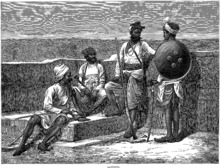
A Rajput (from Sanskrit raja-putra, “son of a king”) is a member of one of the patrilineal clans of western, central, northern India and in some parts of Pakistan. They claim to be descendants of ruling Hindu warrior classes of North India.[1] Rajputs rose to prominence during the 6th to 12th centuries. Until the 20th century Rajputs ruled in the "overwhelming majority" of the princely states of Rajasthan and Surashtra, where the largest number of princely states were found.
The Rajput population and the former Rajput states are found spread through much of the subcontinent, particularly in north, west and central India. Populations are found in Rajasthan, Gujarat and Surashtra, Uttar Pradesh, Himachal Pradesh, Haryana, Jammu, Punjab, Uttarakhand, Madhya Pradesh, Bihar, Maharashtra.
The Rajput population and the former Rajput states are found spread through much of the subcontinent, particularly in north, west and central India. Populations are found in Rajasthan, Gujarat and Surashtra, Uttar Pradesh, Himachal Pradesh, Haryana, Jammu, Punjab, Uttarakhand, Madhya Pradesh, Bihar, Maharashtra.
Origins

Various scholars have different theories of rajput origin.Not until the Mughal period did the word Rajput come to be used of a particular class or tribe.Initially the term had no particular etnic or regional connotations.There is no mention of the term Rajput in the historical record as pertaining to a social group prior to the 6th century AD. According to one theory, bulk of rajputs originated from foreign invaders.However scholars such as CV Vaidya and Gauri Shnakar Ojha don't accept this theory.Dr.VA Smith hold that rajputs were of mixed origin, some of them being descendant from Gurjars, Huns etc and other from aboriginal tribes Gonds, Bhars etc.
With the collapse of the Gupta empire from the late 6th century, the invading Hephthalites (White Huns) were probably integrated within the Indian society. Leaders and nobles from among the invaders were assimilated into the Kshatriya ritual rank in the Hindu varna system, while others who followed and supported them - such as the Ahirs, Gurjars and Jats - were ranked lower in their precedence.This theory is not accepted by scholars such as CV Vaidya and Gauri Shankar Ojha.At the same time, some indigenous tribes were ranked as being of the "rajput" Kshatriya status, examples of which are the Bundela, Chandelas and Rathors. The Encyclopaedia Britannica notes that Rajputs "... actually vary greatly in status, from princely lineages, such as the Guhilot and Kachwaha, to simple cultivators."
With the collapse of the Gupta empire from the late 6th century, the invading Hephthalites (White Huns) were probably integrated within the Indian society. Leaders and nobles from among the invaders were assimilated into the Kshatriya ritual rank in the Hindu varna system, while others who followed and supported them - such as the Ahirs, Gurjars and Jats - were ranked lower in their precedence.This theory is not accepted by scholars such as CV Vaidya and Gauri Shankar Ojha.At the same time, some indigenous tribes were ranked as being of the "rajput" Kshatriya status, examples of which are the Bundela, Chandelas and Rathors. The Encyclopaedia Britannica notes that Rajputs "... actually vary greatly in status, from princely lineages, such as the Guhilot and Kachwaha, to simple cultivators."
Early history (6th to 8th centuries)
Akhand Pratap Singh, a Rajput king, came to Rajasthan and built a fort at Bathinda on the banks of Sutlej river and declared it to be the capital. He occupied the areas up to Peshawar. Rajputs remained in power in Punjab till 1010 AD.[citation needed]
See also: Battle of Rajasthan
According to some sources,[citation needed] Bin Qasim attacked Chittorgarh, in Rajasthan, and was defeated by Bappa Rawal. Invasions by marauding Yavanas are also recorded in this era.[citation needed] Lalitaditya Muktapida of Kashmir defeated one such Yavana invasion in the 8th century and the Gurjara-Pratihara empire rebuffed another in the 9th century
See also: Battle of Rajasthan
According to some sources,[citation needed] Bin Qasim attacked Chittorgarh, in Rajasthan, and was defeated by Bappa Rawal. Invasions by marauding Yavanas are also recorded in this era.[citation needed] Lalitaditya Muktapida of Kashmir defeated one such Yavana invasion in the 8th century and the Gurjara-Pratihara empire rebuffed another in the 9th century
Rajput kingdoms (8th to 11th centuries)
The Kachwahas or Kacchapghata dynasty were originally from Bihar; they founded Gwalior and Narwar in the 8th century.[citation needed] From the beginning of the 9th century, Rajput dynasties dominated northern parts of India, and the many petty Rajput kingdoms became the primary obstacle to the complete Muslim conquest of Hindu India. Even after the Muslim conquest of the Punjab and the Ganga River valley, the Rajputs maintained their independence in Rajasthan and the forests of central India. Later, Sultan Alauddin Khilji of Khilji dynasty took the two Rajput forts of Chitor and Ranthambhor in eastern Rajasthan but could not hold them for long.

The imperial Pratiharas established their rule over Malwa and ruled from the cities of Bhinmal and Ujjain in the 8th and 9th centuries. One branch of the clan established a state in Mandore in the Marwar region in 6th and 7th centuries where they held sway until they were supplanted by the Rathores in the 14th century. Around 816 CE, the Pratiharas of Ujjain conquered Kannauj, and from this city they ruled much of northern India for a century. They went into decline after Rashtrakuta invasions in the early 10th century.
The Chandela clan ruled Bundelkhand after the 10th century, occupying Kalinjar Fort; they later built the temples at Khajuraho Group of Monuments.
Dulah Rai, who was a descendant of the Kachwahas (grandson of Raja Isha Singh and son of Prince Sodh Dev of Narwar), established his rule in Dhundhar in the 11th century.
In 1156 Rawal Jaisal Bhati, the sixth in succession from Deoraj, founded the fort and city of Jaisalmer, and made it the capital of Jaisalmer state, as he moved from his former capital at Lodhruva (which is situated about 15 km to the north-west of Jaisalmer).
The organisation of Rajput clans crystallised in this period. Intermarriage among the Rajput clans interlinked the various regions of India and Pakistan, facilitating the flow of trade and scholarship. Archaeological evidence and contemporary texts suggest that Indian society achieved significant prosperity during this era.
The early 11th century saw the reign of the polymath King Bhoja, Paramara ruler of Malwa. He was not only a patron of literature and the arts but was a distinguished writer. His Samarangana Sutradhara deals with architecture and his Raja-Martanda is a commentary on the Yoga Sutras of Patanjali. Many major monuments of northern and central India, including those at Khajuraho, date from this period.
The Chandela clan ruled Bundelkhand after the 10th century, occupying Kalinjar Fort; they later built the temples at Khajuraho Group of Monuments.
Dulah Rai, who was a descendant of the Kachwahas (grandson of Raja Isha Singh and son of Prince Sodh Dev of Narwar), established his rule in Dhundhar in the 11th century.
In 1156 Rawal Jaisal Bhati, the sixth in succession from Deoraj, founded the fort and city of Jaisalmer, and made it the capital of Jaisalmer state, as he moved from his former capital at Lodhruva (which is situated about 15 km to the north-west of Jaisalmer).
The organisation of Rajput clans crystallised in this period. Intermarriage among the Rajput clans interlinked the various regions of India and Pakistan, facilitating the flow of trade and scholarship. Archaeological evidence and contemporary texts suggest that Indian society achieved significant prosperity during this era.
The early 11th century saw the reign of the polymath King Bhoja, Paramara ruler of Malwa. He was not only a patron of literature and the arts but was a distinguished writer. His Samarangana Sutradhara deals with architecture and his Raja-Martanda is a commentary on the Yoga Sutras of Patanjali. Many major monuments of northern and central India, including those at Khajuraho, date from this period.
Islamic invasions (11th to 12th centuries)
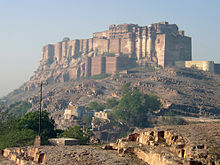
The fertile and prosperous plains of northern India had always been a destination of choice for streams of invaders coming from the northwest. The last of these waves of invasions were of tribes who had previously converted to Islam. For geographic reasons, Rajput-ruled states suffered the brunt of aggression from various Mongol–Turkic–Afghan warlords who repeatedly invaded the subcontinent. In his New History of India Stanley Wolpert wrote, "The Rajputs were the vanguard of Hindu India in the face of the Islamic onslaught."
In the early 11th century, Mahmud of Ghazni conquered the Hindu Kabul Shahi kingdom in the Punjab. His raids into northern India weakened the Pratihara kingdom, which was drastically reduced in size and came under the control of the Chandelas. In 1018 CE, Mahmud sacked the city of Kannauj, seat of the Pratihara kingdom, but withdrew immediately to Ghazni, being interested in booty rather than empire. In the ensuing chaos, the Gahadvala dynasty established a modest state centred around Kannauj, ruling for about a hundred years. They were defeated by Muhammad of Ghor, who sacked the city in 1194 CE.
Meanwhile, a nearby state centred around present-day Delhi was ruled successively by the Tomara and Chauhan clans. Prithviraj Chauhan, ruler of Delhi, defeated Muhammad of Ghor at the First Battle of Tarain (1191 CE). Muhammad returned the following year and defeated Prithviraj at the Second Battle of Tarain in 1192 CE. In this battle, as in many others of this era, rampant internecine conflict among Rajput kingdoms facilitated the victory of the invaders.
In the late 11th century, a battle between Parmal and Prithviraj Chauhan took place in Mahoba, a small town in Uttar Pradesh. Alha and Udal were the generals of Parmal's army, who fought bravely but lost the battle.
In the early 11th century, Mahmud of Ghazni conquered the Hindu Kabul Shahi kingdom in the Punjab. His raids into northern India weakened the Pratihara kingdom, which was drastically reduced in size and came under the control of the Chandelas. In 1018 CE, Mahmud sacked the city of Kannauj, seat of the Pratihara kingdom, but withdrew immediately to Ghazni, being interested in booty rather than empire. In the ensuing chaos, the Gahadvala dynasty established a modest state centred around Kannauj, ruling for about a hundred years. They were defeated by Muhammad of Ghor, who sacked the city in 1194 CE.
Meanwhile, a nearby state centred around present-day Delhi was ruled successively by the Tomara and Chauhan clans. Prithviraj Chauhan, ruler of Delhi, defeated Muhammad of Ghor at the First Battle of Tarain (1191 CE). Muhammad returned the following year and defeated Prithviraj at the Second Battle of Tarain in 1192 CE. In this battle, as in many others of this era, rampant internecine conflict among Rajput kingdoms facilitated the victory of the invaders.
In the late 11th century, a battle between Parmal and Prithviraj Chauhan took place in Mahoba, a small town in Uttar Pradesh. Alha and Udal were the generals of Parmal's army, who fought bravely but lost the battle.
Medieval Rajput states (12th to 16th centuries)
Prithviraj Chauhan proved to be the last Rajput ruler of Delhi. The Chauhans, led by Govinda, grandson of Prithviraj, later established a small state centered around Ranthambore in present-day Rajasthan. The Songara branch of the Chauhan clan later ruled Jalore, while the Hada branch established their rule over the Hadoti region in the mid-13th century. The Rever Maharaja Ranavghansinh ruled Taranga in the 11th century. The Tomaras later established themselves at Gwalior, and the ruler Man Singh built the fortress which still stands there. Muhammad's armies brought down the Gahadvala kingdom in 1194 CE. Some surviving members of the Gahadvala dynasty are said to have taken refuge to the western desert, formed the Rathore clan, and later founded the state of Marwar. The Kachwaha clan came to rule Dhundhar (later Jaipur) with their capital at Amber.
Other relocations surmised to have occurred in this period include the emigration of Rajput clans to the Himalayas. The Katoch clan, the Chauhans of Chamba and certain clans of Uttarakhand and Nepal are counted among this number.
Other relocations surmised to have occurred in this period include the emigration of Rajput clans to the Himalayas. The Katoch clan, the Chauhans of Chamba and certain clans of Uttarakhand and Nepal are counted among this number.
Conflict with the Sultanate
The Delhi Sultanate was founded by Qutb ud din Aybak, Muhammad of Ghor's successor, in the early 13th century. Sultan Ala ud din Khilji conquered Gujarat (1297), Malwa (1305), Ranthambore (1301), Chittorgarh (1303), Jalore, and Bhinmal (1311). All were conquered after long sieges and fierce resistance from their Rajput defenders.
The "First Jauhar" occurred during the siege of Chittor (1303). Jauhar is the mass self-immolation of the female population to avoid capture in time of war. Concurrently, the male population would perform Saka: a fight to the death against impossible odds. The defence of Chittor by the Guhilas, the sagas of Rani Padmini, and the memory of the Jauhar have had a defining impact upon the Rajput character.
Ala ud din Khilji delegated the administration of the newly conquered areas to his principal Rajput collaborator, Maldeo Songara, ruler of Jalore. Maldeo Songara was soon displaced by his son-in-law Hammir, a scion of the lately displaced Guhila clan, who re-established the state of Mewar c. 1326 CE. Mewar was to emerge as a leading Rajput state, after Rana Kumbha expanded his kingdom at the expense of the sultanates of Malwa and Gujarat.
The "First Jauhar" occurred during the siege of Chittor (1303). Jauhar is the mass self-immolation of the female population to avoid capture in time of war. Concurrently, the male population would perform Saka: a fight to the death against impossible odds. The defence of Chittor by the Guhilas, the sagas of Rani Padmini, and the memory of the Jauhar have had a defining impact upon the Rajput character.
Ala ud din Khilji delegated the administration of the newly conquered areas to his principal Rajput collaborator, Maldeo Songara, ruler of Jalore. Maldeo Songara was soon displaced by his son-in-law Hammir, a scion of the lately displaced Guhila clan, who re-established the state of Mewar c. 1326 CE. Mewar was to emerge as a leading Rajput state, after Rana Kumbha expanded his kingdom at the expense of the sultanates of Malwa and Gujarat.
Mughal era (16th–18th century)
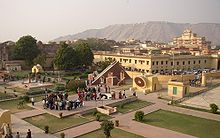
The Delhi sultanate was extinguished when Babur defeated Ibrahim Lodi at the First Battle of Panipat in 1526. Rana Sanga, ruler of Mewar, rallied an army to challenge Babur. Rana Sanga used traditional war tactics and weapons and Babur used modern tactics and cannons, the first example of their use in northern India. Overmatched, Sanga was defeated by Babur at the Battle of Khanua on March 16, 1527. However, it was not until the reign of Akbar fifteen years later that the structure of relations between the Mughal imperium and the Rajput states began to take definitive shape.
Maharana Pratap Singh of Mewar

Main article: Pratap Singh of Mewar
Pratap Singh of Mewar, a 16th century Rajput ruler and great warrior. The Mughal emperor Akbar sent many missions against him. He survived to ultimately gain control of all of Mewar, excluding Chittorgarh Fort.
Udaipur City Palace Udaipur remained the capital of Mewar after the fall of Chittor until its accession in independent India.
The region of Mewar held out against the Mughal empire and gave battle to all invaders. Rana Sanga, the grandfather of Rana Pratap, fought against Babur. Later, Babur's grandson Akbar attacked Chittor in 1567 CE. After a struggle, Mewar's chief citadel of Chittor finally fell to Akbar in 1568. The third (and last) Jauhar of Chittor transpired on this occasion. When the fall of the citadel became imminent, the ladies of the fort committed collective self-immolation to save their chastity, and the men sallied out of the fort to meet the invading Muslim army in a fight to the death.
Prior to this event, Mewar's ruler, Rana Udai Singh II, had retired to the nearby hills where he founded the new town of Udaipur. He was succeeded while in exile by his son Pratap Singh of Mewar as head of the Sisodia clan. Under the able leadership of Pratap Singh, they harassed the Mughals enough to cause them to make accommodatory overtures. Pratap Singh, a present-day Rajput icon, rebuffed these overtures of friendship from Akbar and rallied an army to meet the Mughal forces. He was defeated by the Mughal forces at the battle of Haldighati in June 1576. He escaped and carried out a relentless guerilla struggle from his hideout in the hills, and by the time of his death, he had reconquered nearly all of his kingdom from the Mughals except for the fortress of Chittor and Mandal Garh. He died in 1597 CE.
Pratap Singh of Mewar, a 16th century Rajput ruler and great warrior. The Mughal emperor Akbar sent many missions against him. He survived to ultimately gain control of all of Mewar, excluding Chittorgarh Fort.
Udaipur City Palace Udaipur remained the capital of Mewar after the fall of Chittor until its accession in independent India.
The region of Mewar held out against the Mughal empire and gave battle to all invaders. Rana Sanga, the grandfather of Rana Pratap, fought against Babur. Later, Babur's grandson Akbar attacked Chittor in 1567 CE. After a struggle, Mewar's chief citadel of Chittor finally fell to Akbar in 1568. The third (and last) Jauhar of Chittor transpired on this occasion. When the fall of the citadel became imminent, the ladies of the fort committed collective self-immolation to save their chastity, and the men sallied out of the fort to meet the invading Muslim army in a fight to the death.
Prior to this event, Mewar's ruler, Rana Udai Singh II, had retired to the nearby hills where he founded the new town of Udaipur. He was succeeded while in exile by his son Pratap Singh of Mewar as head of the Sisodia clan. Under the able leadership of Pratap Singh, they harassed the Mughals enough to cause them to make accommodatory overtures. Pratap Singh, a present-day Rajput icon, rebuffed these overtures of friendship from Akbar and rallied an army to meet the Mughal forces. He was defeated by the Mughal forces at the battle of Haldighati in June 1576. He escaped and carried out a relentless guerilla struggle from his hideout in the hills, and by the time of his death, he had reconquered nearly all of his kingdom from the Mughals except for the fortress of Chittor and Mandal Garh. He died in 1597 CE.
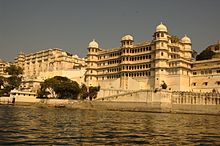
After Rana pratap Singh's death, his son Rana Amar Singh continued the struggle for 18 years and faced constant attacks from Mughals. He fought eighteen wars during this period. Finally, he entered into a peace treaty with the Mughals but with certain exemptions: the Rana of Mewar did not have to attend the Mughal court personally, but the crown prince would attend the court, and it was not necessary for the Rana and the Sisodias to enter into marriage alliances with the Mughals. The treaty was signed by Rana Amar Singh and Prince Khurram Shihab-ud-din Muhammad (later Shah Jahan) in 1615 CE at Gogunda. Singh thus regained control of his state as a vassal of the Mughals. The Sisodias, rulers of Mewar, were the last Rajput dynasty to enter into an alliance with the Mughals.
The internal conflicts which existed among the Rajput communities were significant in enabling the Mughal invaders to achieve control over them, while nonetheless recognising the role of the Rajputs as a ruling class. European travellers of the period also documented this internal strife and, noting that the Rajputs ate meat and used opium, believed that those two traits explained their passionate nature.
The internal conflicts which existed among the Rajput communities were significant in enabling the Mughal invaders to achieve control over them, while nonetheless recognising the role of the Rajputs as a ruling class. European travellers of the period also documented this internal strife and, noting that the Rajputs ate meat and used opium, believed that those two traits explained their passionate nature.
Maratha Empire

As the central authority of the Mughal empire disintegrated following the death of Aurangzeb, the power of the Marathas was being consolidated under the leadership of Shivaji Bhonsle (his grandfather, Maloji Bhonsle, claimed descent from the Sisodia clan of Rajputs). The only major defeat in Shivaji's rise to power came against the Kachwaha ruler, Mirza Raja Jai Singh I of Amber, who was commanded by Mughal emperor Aurangzeb (ruled 1658–1707). When in Agra, on a visit to Aurangzeb, Shivaji was deceitfully kept under house arrest. With the assistance of Mirza Raja Jai Singh I and his son Ram Singh I, Shivaji managed to escape to the Maratha Empire.
Having been able to cross the Narmada River by 1728, Peshwa Bajirao and his successor Balaji Bajirao were able to organise military expeditions initially into Malwa and then into other parts of Hindustan. By 1760, with defeat of the Nizam of Hyderabad in the Deccan, Maratha power had reached its zenith with a territory of over a territory of over 2,800,000 km². The Maratha expansion was temporarily halted after their defeat in the Third Battle of Panipat in 1761. For the Rajput states of the former empire in the north of the Indian subcontinent it was a period of constantly shifting alliances and military conflicts with the various forces competing for power.
The Maratha's constant attempt to extract tribute and conduct raids greatly antagonised the people of the Rajput states and Jat community and was one of the reasons for the emergence of military alliances between the Rajput states and the East India Company by the early 19th century. In a notable incident of this period, Jayappa Scindia, one of the Maratha generals, was murdered at Nagaur while trying to collect taxes. In another incident, Ishwari Singh, ruler of Jaipur, committed suicide. The public of Jaipur was very much infuriated by this incident. On January 20, 1751, when 4,000 Maratha soldiers came on an informal visit to Jaipur, all the gates of the city were closed, and the Rajput army along with the civilian population attacked the Marathas and killed them. Almost 3,000 Marathas died. 1,000 were injured and managed to escape.
In May 1787 the Marathas suffered a defeat in the Battle of Lalsot. On June 20, 1790, the Battle of Patan was fought between the Maratha Confederacy and the Rajputs of Jaipur and their Mughal allies, in which the Rajputs suffered a severe blow. The Marathas demanded taxes and damages. The Rana of Mewar could not pay these taxes and had to mortgage some of his properties to the Scindia family to raise the funds.
The Rajput states remained loyal to the Mughals. But the Mughals changed their liberal policy towards Rajputs and other Hindus, resulting in a major Hindu revolt by the Sikhs, Jats, Marathas, Satnamis and Rajputs. The outrage ultimately weakened the Mughal empire irreparably. At the last the emperor became merely a nominal head. Mughals fought among themselves and Rajputs were unjustifiably held responsible for the fighting. In this uncertainty and chaos the Rajputs chose to begin to withdraw their support from the Mughals. Whether they physically supported the Mughals with troops depended upon their own interests and the status quo of the respective states. This became the main concern of the rulers of Delhi and other Rajput states, rather than the reemergence of a powerful Mughal regime. The English East India Company established control in 1757 after the Battle of Plassey, where they defeated the Nawab of Bengal. After a period of chaos and unrest culminating in the Indian Rebellion of 1857, Queen Victoria was declared Empress of India on 1 May 1876, officially supplanting the last Mughal emperor Bahadur Shah II and the rule of the East India Company.
Having been able to cross the Narmada River by 1728, Peshwa Bajirao and his successor Balaji Bajirao were able to organise military expeditions initially into Malwa and then into other parts of Hindustan. By 1760, with defeat of the Nizam of Hyderabad in the Deccan, Maratha power had reached its zenith with a territory of over a territory of over 2,800,000 km². The Maratha expansion was temporarily halted after their defeat in the Third Battle of Panipat in 1761. For the Rajput states of the former empire in the north of the Indian subcontinent it was a period of constantly shifting alliances and military conflicts with the various forces competing for power.
The Maratha's constant attempt to extract tribute and conduct raids greatly antagonised the people of the Rajput states and Jat community and was one of the reasons for the emergence of military alliances between the Rajput states and the East India Company by the early 19th century. In a notable incident of this period, Jayappa Scindia, one of the Maratha generals, was murdered at Nagaur while trying to collect taxes. In another incident, Ishwari Singh, ruler of Jaipur, committed suicide. The public of Jaipur was very much infuriated by this incident. On January 20, 1751, when 4,000 Maratha soldiers came on an informal visit to Jaipur, all the gates of the city were closed, and the Rajput army along with the civilian population attacked the Marathas and killed them. Almost 3,000 Marathas died. 1,000 were injured and managed to escape.
In May 1787 the Marathas suffered a defeat in the Battle of Lalsot. On June 20, 1790, the Battle of Patan was fought between the Maratha Confederacy and the Rajputs of Jaipur and their Mughal allies, in which the Rajputs suffered a severe blow. The Marathas demanded taxes and damages. The Rana of Mewar could not pay these taxes and had to mortgage some of his properties to the Scindia family to raise the funds.
The Rajput states remained loyal to the Mughals. But the Mughals changed their liberal policy towards Rajputs and other Hindus, resulting in a major Hindu revolt by the Sikhs, Jats, Marathas, Satnamis and Rajputs. The outrage ultimately weakened the Mughal empire irreparably. At the last the emperor became merely a nominal head. Mughals fought among themselves and Rajputs were unjustifiably held responsible for the fighting. In this uncertainty and chaos the Rajputs chose to begin to withdraw their support from the Mughals. Whether they physically supported the Mughals with troops depended upon their own interests and the status quo of the respective states. This became the main concern of the rulers of Delhi and other Rajput states, rather than the reemergence of a powerful Mughal regime. The English East India Company established control in 1757 after the Battle of Plassey, where they defeated the Nawab of Bengal. After a period of chaos and unrest culminating in the Indian Rebellion of 1857, Queen Victoria was declared Empress of India on 1 May 1876, officially supplanting the last Mughal emperor Bahadur Shah II and the rule of the East India Company.
The British colonial period
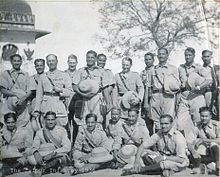
The Maratha Confederacy began to be in conflict with the British Raj beginning in 1772. After the Third Anglo-Maratha War (1817–1818), all the states in the Rajputana region, entered into subsidiary alliance with the East India Company and became princely states under the British Raj. The British took direct control of Ajmer, which became the province of Ajmer-Merwara There were about 13 main Rajput states and 2 Jat states namely Bharatpur & Dholpur in Rajasthan region.During British regime three more states were created in Rajputana.They were Tonk, Jhalawar and Dholpur. A large number of other Rajput states in central and western India made a similar transition. Most of them were placed under the authority of the Central India Agency and the various states' agencies of Kathiawar.
Rajput army officers with British army officers in 1936
Some British colonial officials were impressed by the military qualities of the Rajputs. In his Annals and Antiquities of Rajasthan James Tod writes:
What nation on earth could have maintained the semblance of civilization, the spirit or the customs of their forefathers, during so many centuries of overwhelming depression, but one of such singular character as the Rajpoot? ... Rajast'han exhibits the sole example in the history of mankind, of a people withstanding every outrage barbarity could inflict, or human nature sustain, from a foe whose religion commands annihilation; and bent to the earth, yet rising buoyant from the pressure, and making calamity a whetstone to courage .... Not an iota of their religion or customs have they lost ...
In this instance, it should be noted that Tod was unusually enamoured of the Rajputs, is venerated by them to this day, and is viewed by many historians since the late nineteenth-century as being a not particularly reliable commentator.Jason Freitag, his only significant biographer, has said that Tod is "manifestly biased".
The Rajput practice of female infanticide and sati (widow immolation) was another matter regarding which the British colonialists had an interest. It was believed that the Rajputs were the primary adherents to these practices, which the Raj considered to be savage and which was the initial impetus for British ethnographic studies of the subcontinent that eventually manifested itself as a much wider exercise in social engineering.
In reference to the role of the Rajput soldiers serving under the British banner, Captain A. H. Bingley states:
Rajputs have served in our ranks from Plassey to the present day (1899). They have taken part in almost every campaign undertaken by the Indian armies. Under Forde they defeated the French at Condore. Under Monro at Buxar they routed the forces of the Nawab of Oudh. Under Lake they took part in the brilliant series of victories which destroyed the power of the Marathas.
Bingley went on to describe the role of the Rajput infantries in the Gurkha War (1814 to 1816) and the Anglo-Afghan Wars, and stated that the Rajput troops were instrumental in the victory of the Anglo-Sikh wars in Punjab. He detailed the role the Rajput troopers in the Egyptian campaign of 1882 as well as their victorious action in the Third Anglo-Burmese War of 1885.[Full citation needed] The Rajputs retained their principal role in Indian society, serving in armies wherever necessary throughout this period, as they do to this day. Rajput soldiers remain an integral part in the armies of India and Pakistan.
When India gained its independence in 1947, the Rajput states became a part of the Dominions of India and Pakistan.
Rajput army officers with British army officers in 1936
Some British colonial officials were impressed by the military qualities of the Rajputs. In his Annals and Antiquities of Rajasthan James Tod writes:
What nation on earth could have maintained the semblance of civilization, the spirit or the customs of their forefathers, during so many centuries of overwhelming depression, but one of such singular character as the Rajpoot? ... Rajast'han exhibits the sole example in the history of mankind, of a people withstanding every outrage barbarity could inflict, or human nature sustain, from a foe whose religion commands annihilation; and bent to the earth, yet rising buoyant from the pressure, and making calamity a whetstone to courage .... Not an iota of their religion or customs have they lost ...
In this instance, it should be noted that Tod was unusually enamoured of the Rajputs, is venerated by them to this day, and is viewed by many historians since the late nineteenth-century as being a not particularly reliable commentator.Jason Freitag, his only significant biographer, has said that Tod is "manifestly biased".
The Rajput practice of female infanticide and sati (widow immolation) was another matter regarding which the British colonialists had an interest. It was believed that the Rajputs were the primary adherents to these practices, which the Raj considered to be savage and which was the initial impetus for British ethnographic studies of the subcontinent that eventually manifested itself as a much wider exercise in social engineering.
In reference to the role of the Rajput soldiers serving under the British banner, Captain A. H. Bingley states:
Rajputs have served in our ranks from Plassey to the present day (1899). They have taken part in almost every campaign undertaken by the Indian armies. Under Forde they defeated the French at Condore. Under Monro at Buxar they routed the forces of the Nawab of Oudh. Under Lake they took part in the brilliant series of victories which destroyed the power of the Marathas.
Bingley went on to describe the role of the Rajput infantries in the Gurkha War (1814 to 1816) and the Anglo-Afghan Wars, and stated that the Rajput troops were instrumental in the victory of the Anglo-Sikh wars in Punjab. He detailed the role the Rajput troopers in the Egyptian campaign of 1882 as well as their victorious action in the Third Anglo-Burmese War of 1885.[Full citation needed] The Rajputs retained their principal role in Indian society, serving in armies wherever necessary throughout this period, as they do to this day. Rajput soldiers remain an integral part in the armies of India and Pakistan.
When India gained its independence in 1947, the Rajput states became a part of the Dominions of India and Pakistan.
Rajput lifestyle
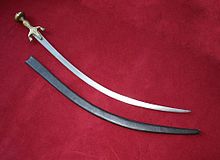
The double-edged scimitar known as the khanda was a popular weapon among the Rajputs of that era. On special occasions, a primary chief would break up a meeting of his vassal chiefs with khanda nariyal, the distribution of daggers and coconuts. Another affirmation of the Rajput's reverence for his sword was the Karga Shapna ("adoration of the sword") ritual, performed during the annual Navaratri festival, after which a Rajput is considered "free to indulge his passion for rapine and revenge".
By the late 19th century, there was a shift of focus among Rajputs from politics to a concern with kinship. Many Rajputs of Rajasthan are nostalgic about their past and keenly conscious of their genealogy, emphasizing a Rajput ethos that is martial in spirit, with a fierce pride in lineage and tradition
By the late 19th century, there was a shift of focus among Rajputs from politics to a concern with kinship. Many Rajputs of Rajasthan are nostalgic about their past and keenly conscious of their genealogy, emphasizing a Rajput ethos that is martial in spirit, with a fierce pride in lineage and tradition



















